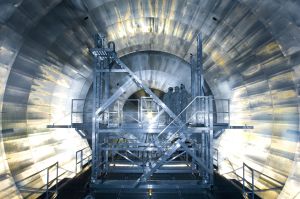Highly sensitive detectors are used in basic research as well as in applied research. But they are also required in many everyday applications. The Helmholtz Association is now setting up a platform in order to further develop technologies and systems for building detectors of photons, neutrons, and charged particles. The KIT is the coordinating institution for the platform. Further participating institutions are six more Helmholtz Centers and two Helmholtz Institutes, as well as an increasing number of high profile research institutions and universities worldwide.
Each digital camera incorporates photon detectors – be it a professional reflex camera or a smartphone camera. In medical engineering, photon detectors are also very important – for example for the positron emission tomography (PET), an imaging technology for the detection of cancer and other diseases. Neutron detectors are indispensable for basic research in nuclear physics, as well as for radiation protection and civil security. Detectors of charged particles are used in different areas, ranging from elementary particle physics to building installations – for example in smoke detectors.
The coordinating spokesperson of the new Helmholtz Platform for Detector Technology, Professor Marc Weber, Head of the Institute for Data Processing and Electronics (IPE) at KIT, says: “Future applications need a new generation of highly integrated detectors, which are more sensitive, work faster and work with growing resolutions. This can only be achieved by a consistent use of three-dimensional detector setups and customized intelligent electronics.” Weber further explains that the platform necessitates the cooperation of a wide range of experts: The subject variety ranges from innovative materials via detector technologies and integrated electronics to intelligent processing of extremely high data rates. The data analysis is increasingly becoming integrated in the detectors. Growing data rates require very fast data transmission rates or data processing close to the detectors. “We provide the basis for the development of more efficient, and at the same time smaller and lighter devices,” says Professor Weber. The researchers aim to increase data transmission rates by a factor of 1 000 and the number of detector channels by factors in between ten and 100.
The new platform will give all participating institutions access to the latest detector technologies and to the detectors based on these technologies. Furthermore, it will enhance the international visibility of German know-how in the field. The Helmholtz Association is funding the Platform for Detector Technology with a total of 13 million Euros as a portfolio theme from 2012 to 2016. Afterwards, research will continue within the framework of the Helmholtz Association’s research programmes. Participating institutions, apart from the Karlsruhe Institute of Technology (KIT), are the Deutsches Elektronen-Synchrotron (DESY), the Forschungszentrum Jülich, the Helmholtz-Zentrum für Schwerionenforschung (GSI), the Helmholtz-Zentrum Berlin für Materialien und Energie (HZB), the Helmholtz-Zentrum Dresden-Rossendorf (HZDR), the Helmholtz-Zentrum Geesthacht Centre for Materials and Coastal Research (HZG), the Helmholtz Institute Jena (HIJ), and the Helmholtz Institute Mainz (HIM). Seven more research institutes and eleven universities from Germany and other countries are participating as associated partners.
In close partnership with society, KIT develops solutions for urgent challenges – from climate change, energy transition and sustainable use of natural resources to artificial intelligence, sovereignty and an aging population. As The University in the Helmholtz Association, KIT unites scientific excellence from insight to application-driven research under one roof – and is thus in a unique position to drive this transformation. As a University of Excellence, KIT offers its more than 10,000 employees and 22,800 students outstanding opportunities to shape a sustainable and resilient future. KIT – Science for Impact.

